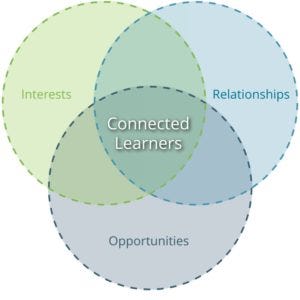Why is a Connected Learner Important in the Workforce?
The future of work is constantly changing. Changes include the impact of a gig economy, an aging workforce, the rapid adoption of artificial intelligence, etc. Organizations who prioritize developing connected learners are gaining a key differentiator against their competition.
Executives are having to find a balance between new, existing and legacy skill sets and how they are able to drive the business forward.1 The Digital Transformation is reinventing business and the skills needed to drive evolving business models.
So how does one develop a team with the skills needed to meet the business goals of tomorrow? They create a culture that empowers connected learners.

What is a Connected Learner?
A connected learner has a personal interest in a topic, a supportive relationship with their peers and supervisors and is given real-world opportunities to expand their skills. When someone has all three of these available to them, learning becomes alluring and life changing. This is a fundamental change from standardized testing, one-to-many instruction and fixed subject teaching.

Why is creating connected learners important?
The traditional way of training employees is failing to empower a workforce that meets the needs of the business. In a world where most aspects of life are personalized to a person’s interests and preferences, why should training be any different?
Organizations need to adapt to the needs of the modern workforce, or they will lose great employees, struggle to attract future talent and in turn lose customers. Creating a culture of connected learners provides the atmosphere current workforce thrives in.
Employees who are actively engaged, allowed to be creative and solve problems they care about will learn skills faster, be more engaged and be more likely to stay with the company. According to Gartner, connected learners are 66% more engaged, learn skills 25% faster and are more than 4x more likely to stay in the company. 1

3 Tips for Creating Connected Learners
Stay Curious
Ask your employees about what they are interested in and be willing to learn along side of them. Perhaps a bank teller wants to know more about credit lending. Be open to connecting him/her to credit lending training opportunities or to shadow a small business credit lender. This isn’t just a one and done question. Check in regularly as interests grow and change over time.
Variety of Learning Opportunities
Not all training is effective for all types of learners. While some may be more comfortable learning in a traditional setting, others may prefer a more modern or tech-forward training environment. Having a trusted education provider who can tailor training to the learner’s preferences will help make this effortless for your learning and development teams.
Allow Specialization When There is Interest
When an employee shows interest in additional education or certification, such as ACAMS, let them, even encourage them. Give them the resources they need to learn on their own, with their peers and about topics that are of interest to them.
In a workforce where the velocity of change shows no sign of slowing, an industry who is risk adverse needs to make big strides in how they empower their workforce in order to keep their talent. Employers who cultivate a culture that grows connected learners will close the skills gap faster, attract top talent and drive the bottom line of their business.
Resources
Top 5 Priorities for HR Leaders in 2020
https://www.gartner.com/en/confirmation/human-resources/trends/thank-you-top-5-priorities-for-hr-leaders-in-2020


Leave A Comment